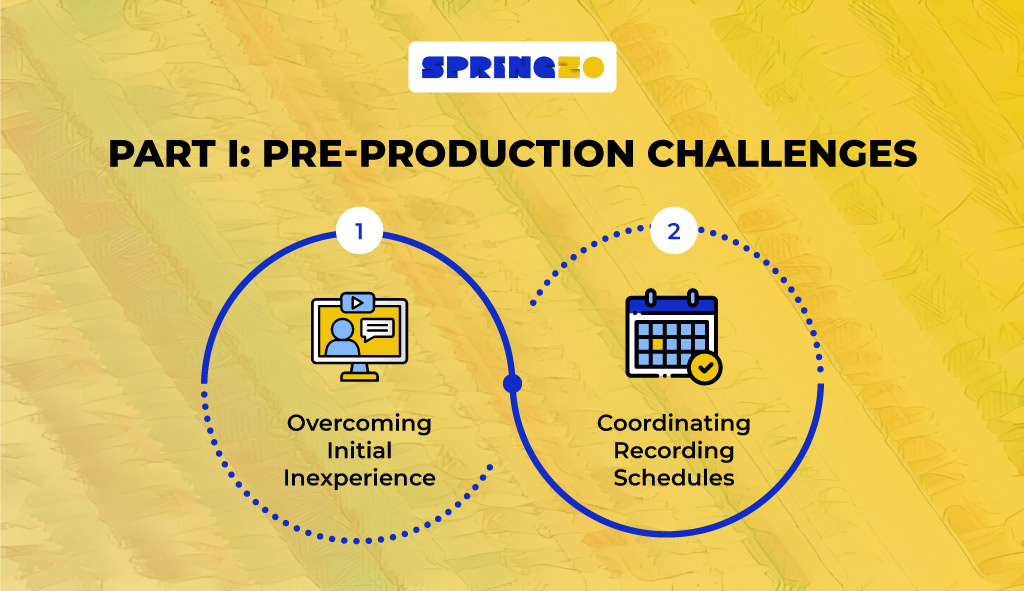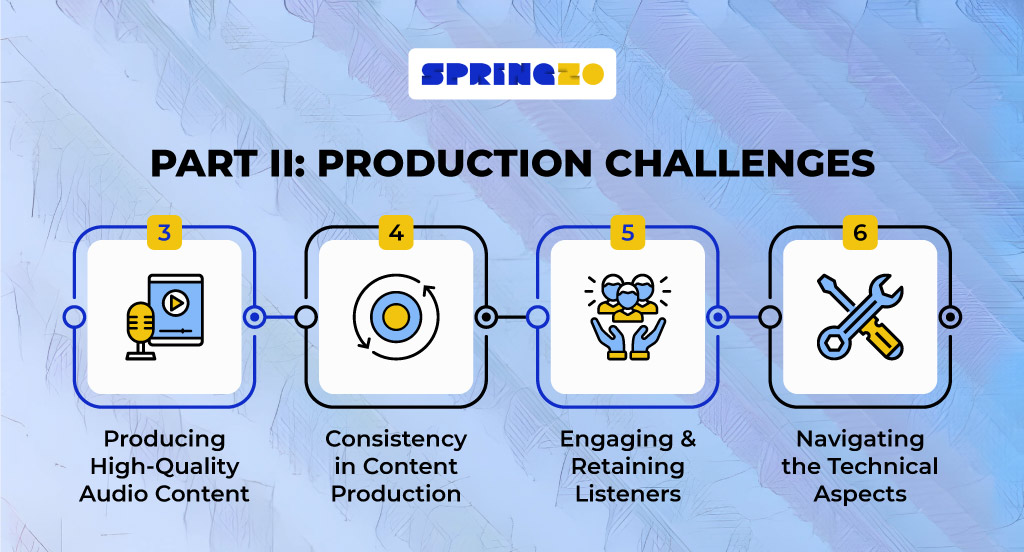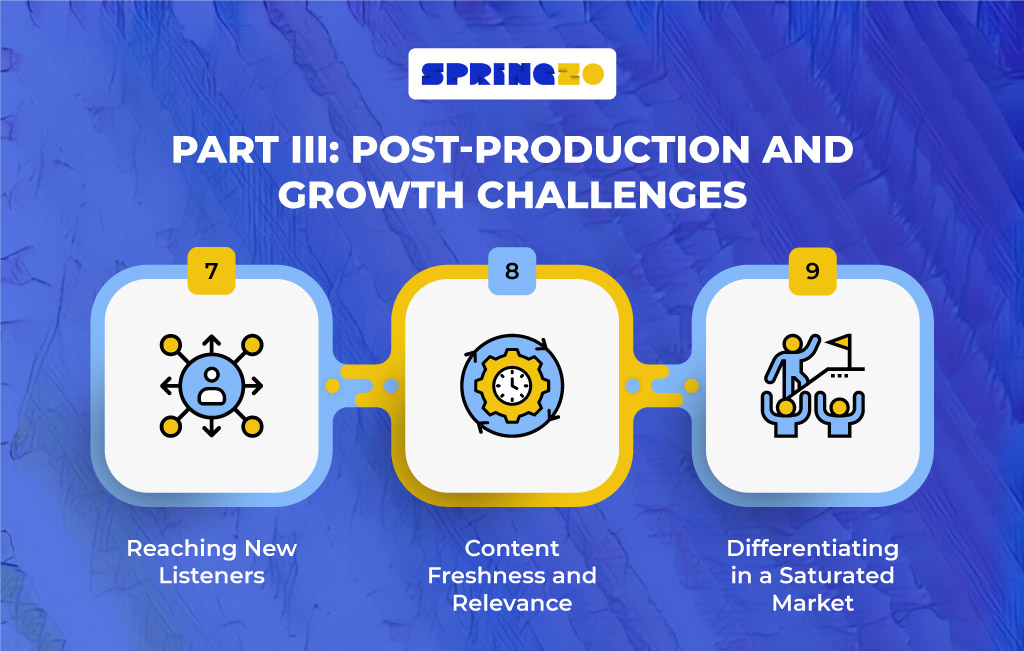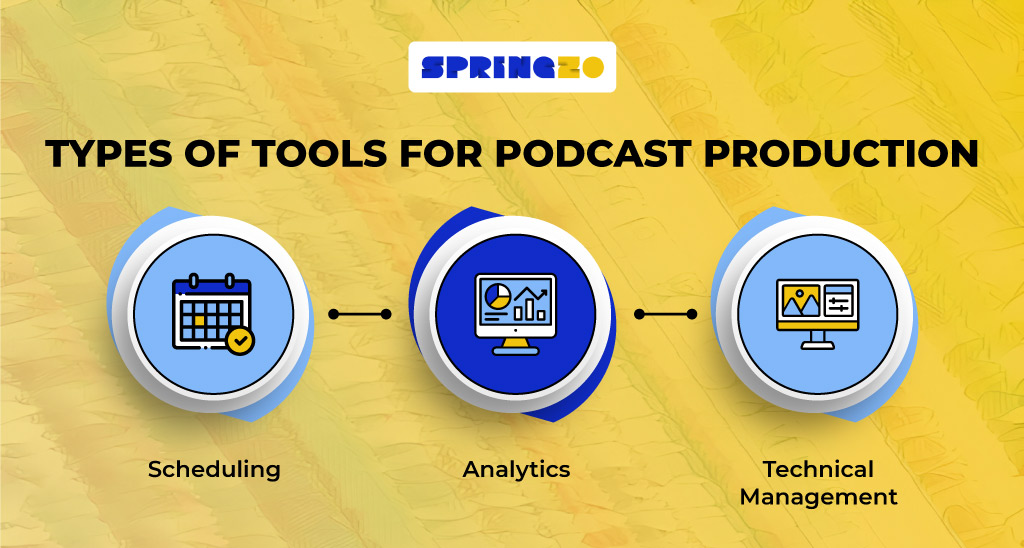In this digital era, podcast production has rapidly emerged as a pivotal element in modern branding strategies. Podcasting, at its core, is a form of audio storytelling that serves multiple purposes—from educating and informing to entertaining and persuading. This format’s capability to engage and retain diverse audiences makes it an invaluable asset for brands aiming to build long-term relationships with their customers. Leveraging podcast production can not only augment the brand voice but also catapulaults you as a thought leader in your industry.
Therefore, the surge in podcast popularity is nothing short of meteoric. As of the last few years, there has been an exponential increase in both the number of podcasts available and the diversity of topics covered. Millions of episodes are downloaded each day, and the audience base spans across demographics, indicating a broad and expanding market.
According to a report by Edison Research, the percentage of Americans who have listened to a podcast in the last month has grown steadily over the last decade, reaching 42% in 2023.
This uptick reflects a sea of change in consumer behavior as audiences increasingly opt for on-the-go, quality content they can consume at their own pace and peace.
However, podcast production is by no means a straightforward journey. From ideation to successful broadcasting, there are numerous challenges and nuances to consider.
As we delve into this comprehensive guide, we will explore the challenges you’re likely to face in podcast production and offer effective solutions that have been thoroughly tried and tested.
Tackling Podcast Production Challenges: From Pre to Post-Production & More
If you’re a brand venturing into podcasting, you must identify the primary challenges that can make or break your podcast production journey.
Part I: Pre-Production Challenges

Navigating the pre-production stage is crucial for the successful launch and sustainability of any podcast. Let’s take a look at the key hurdles and their solutions:
1. Overcoming Initial Inexperience
Problem: Navigating the Initial Learning Curve
The initial stages of podcast production are often fraught with errors and other shortcomings, ranging from poor audio quality to ineffective storytelling. The learning curve of podcast production can be daunting, especially when you’re juggling multiple responsibilities like content creation, marketing, and technical setup.
Solutions
- Utilize Available Educational Resources
The podcasting community is rich with tutorials, courses, and workshops aimed at both beginners and intermediates. Make the most of these resources to understand the intricacies of podcast planning, recording, and editing. Remember, investing in your education can save you from costly mistakes down the line.
Here are some of the latest and most popular resources for podcasting tutorials, courses, and workshops that cater to both beginners and intermediates:
1. DigitalDefynd: This website has compiled a list of 8 best and free podcasting courses available online for 2023. The list includes both free and paid learning resources to discover production and marketing.
2. Buzzsprout: This platform offers a list of 31 of the best podcasting resources available online, which includes courses, guides, and tools that can help you get started with podcasting.
3. Podcasters’ Paradise: This is a podcast membership site with tons of resources for new and existing podcasters. You can access step-by-step video tutorials, podcasting resources, and templates.
- Consistency in Publishing to Learn by Doing
Keep a regular publishing schedule, even if it means starting with shorter episodes. Consistency allows you to iterate and improve, helping you climb the steep learning curve faster.
2. Coordinating Recording Schedules
Problem: Scheduling with Co-hosts or Guests
Bringing in co-hosts or notable guests can add immense value to your podcast, diversifying the conversation and drawing in different audiences. However, coordinating recording schedules can become a logistical nightmare, especially when dealing with people in different time zones or with tight schedules.
Solutions
- Time Management Tools
Time management software like Calendly can automate the scheduling process, allowing co-hosts and guests to choose from available time slots that work for them. This not only saves time but also eliminates the back-and-forth usually associated with scheduling.
- Pre-Booking Recording Slots
Consider blocking out regular time slots in your calendar dedicated solely to podcast recording. Inform your co-hosts or guests of these slots well in advance so they can align their schedules accordingly.
- Backup Schedule for Emergencies
Life is unpredictable. Having a backup recording slot can be a lifesaver when unexpected events force you to reschedule. A buffer ensures that your podcast production remains on track, even when faced with unforeseen challenges.
Part II: Production Challenges

Moving from pre-production to actual production marks a significant milestone in your podcast production journey. Yet, this phase comes with its own set of intricate challenges that can directly impact the quality and success of your podcast.
1. Generating High-Quality Audio Content
Problem: Poor Audio Quality and Distracting Noises
Substandard audio can be a death knell for your podcast, no matter how compelling your content. Listeners can easily be deterred by background noise, popping sounds, or inconsistent audio levels.
Solutions
- Investment in Quality Recording Equipment
High-quality microphones, mixers, and headphones can make a world of difference. Brands like Shure, Audio-Technica, and Zoom offer reliable podcasting gear that can elevate your audio quality to professional levels.
- Utilization of Soundproofing or Professional Studios
If possible, use soundproof rooms or rent a professional recording studio. These environments are designed to eliminate or minimize distracting noises that can compromise audio integrity. Acoustic foam panels can also be used to improve your home studio’s sound quality.
- Post-Production Editing and Sound Mixing
Skilled post-production can remedy many audio issues. Software like Adobe Audition or Audacity can be used to filter out background noise, balance levels, and enhance clarity.
2. Consistency in Production
Problem: Infrequent Episodes and Irregular Messaging
Whimsical episode releases and inconsistent messaging that does not align with your brand can quickly alienate your audience, making your podcast production efforts less effective.
Solutions
- Develop a Content Calendar
Planning your episodes in advance with a content calendar can help maintain consistency. Platforms like Trello or Asana can help you manage topics, guests, and recording schedules efficiently.
- Batch Recording Sessions
Consider recording multiple episodes in a single session to ensure that you always have content ready to publish. This approach minimizes scheduling conflicts and streamlines the production process.
- Assemble a Dedicated Podcast Team or Engage an Agency
If resources allow, hire or allocate a dedicated team for podcast management, from content development to post-production. Alternatively, you can outsource this process to a competent agency that specializes in podcast production services.
3. Engaging and Retaining Listeners
Problem: Declining Listener Numbers and Lack of Engagement
A dwindling audience and low engagement rate is a red flag that your content might not be resonating with the community.
Solutions
- Use of Listener Feedback Mechanisms
Incorporate surveys, reviews, or direct audience Q&As to gauge what your listeners enjoy and what they don’t.
- Cross-promotion with Other Media
If you run a blog or YouTube channel, use these platforms to promote your podcast episodes. Likewise, you can use your podcast to promote other media, creating a symbiotic loop.
- Collaboration with Influential Guests or Similar Brands
Inviting industry experts and thought leaders or collaborating with brands that share your target audience can expose your podcast to new listeners who are likely to stay for your content.
4. Navigating the Technical Aspects
Problem: Technical Issues like Hosting and RSS Feed Errors
Technical glitches can disrupt your podcast distribution, affecting your show’s visibility on platforms like Apple Podcasts or Spotify.
Solutions
- Selecting a Reliable Podcast Hosting Platform
Choosing a reputable hosting platform like Libsyn or Podbean can alleviate many technical issues related to distribution.
- Regular Updates and Feed Tests
Conduct regular RSS feed tests to ensure that your episodes are being properly indexed and updated across all platforms.
- Consulting or Hiring Technical Experts
If you’re not technically savvy, consider hiring a consultant or a full-time technical manager to handle these aspects of podcast production.
Part III: Post-Production and Growth Challenges

After successfully navigating the hurdles of pre-production and production, the next phase of your podcast production journey revolves around growth and sustainability. Despite the potential for an expansive reach, podcasts also face challenges in discoverability, content freshness, and differentiation in a saturated market.
1. Reaching New Listeners
Problem: Limited Organic Discoverability
The podcast realm is enormous, and the discoverability mechanics are not always favorable for new or lesser-known shows. Despite having impressive content, you may not garner adequate listeners.
Solutions
- Cross-promotion with Other Podcasts
Engaging in cross-promotions with podcasts that share your target audience can significantly boost your reach. For example, if you have a tech podcast, you could partner with a popular cybersecurity podcast for mutual promotions.
- Leveraging Social Media and Community
Social platforms like X (formerly Twitter) and Instagram and specialized communities like Reddit’s podcasting subreddit can be goldmines for promotion. Host AMA (Ask Me Anything) sessions, participate in relevant discussions, or share bite-sized snippets to engage potential listeners.
- SEO-Boosting Written Content Like Transcripts
Publishing episode transcripts or related articles can substantially increase your podcast’s search engine visibility. This can be particularly effective if you discuss trending topics or interview high-profile guests.
2. Content Freshness and Relevance
Problem: Running out of Engaging Content
Maintaining a consistently interesting podcast can be difficult, particularly if you’ve covered your most passionate subjects.
Solutions
- Continuous Audience Feedback
Periodic surveys or social media polls can yield valuable insights into what your audience wants. For instance, you could ask your X (formerly Twitter) followers to vote on a selection of upcoming episode topics.
- Keeping an Ear on Industry Trends
Staying updated with the latest industry news can offer a constant stream of fresh material. News aggregators like Feedly or Google Alerts can help you monitor relevant developments.
- Regular Brainstorming Sessions
Holding frequent brainstorming sessions with your podcast production team or even with engaged audience members can generate new perspectives and ideas.
3. Differentiating in a Saturated Market
Problem: Overcrowded Marketplace
With the growing popularity of podcasts, the market can appear extremely saturated. Creating your own mark and an audience base could be a Herculean task.
Solutions
- Carving out a Unique Niche or Perspective
Rather than covering broad topics, focus on a specific niche. For example, instead of a general “health and wellness” podcast, you could focus on “holistic mental health for busy professionals.”
- Collaborative Partnerships for Co-promotion
Strategic partnerships with brands or platforms can offer mutual benefits. For instance, you could co-create content with a popular YouTube channel in your industry.
- Fostering an Active and Engaged Listener Community
Building a dedicated community can be one of the most potent ways to stand out. Utilize platforms like Discord or Slack to create a space where your listeners can engage with you and each other.
Part IV: Financial Challenges and Monetization
Successfully navigating through the pre-production, production, and post-production stages of podcast production is a feat in itself. However, the sustainability of your podcasting venture ultimately hinges on one crucial factor: monetization. Let’s elaborate.
1. Monetizing Your Podcast
Problem: Ensuring Financial Sustainability
While creating a podcast can be a labor of love, financial sustainability is often the elephant in the room. Many podcasters grapple with questions about how to monetize their content without alienating their audience.
Solutions
- Sponsorships and Partnerships
One of the most straightforward ways to monetize is through sponsorships. Brands are increasingly interested in podcasts as an advertising medium because of their highly engaged audiences. For example, if you run a podcast about digital marketing, companies that sell marketing software could be excellent sponsorship prospects.
- Listener-Supported Revenue Models
Another popular monetization strategy is listener support through platforms like Patreon. In this model, listeners subscribe to exclusive content or benefits for a monthly fee. Marc Maron, host of the “WTF with Marc Maron” podcast, uses Patreon to provide premium content to subscribers, enhancing his revenue stream.
- Utilizing Existing Brand Assets and Communities for Monetization
If you’re a brand or an influencer with an existing following, you can leverage these assets to drive listenership and monetization. For instance, if you have a well-established e-commerce website, you can use your podcast to direct traffic to your online store, thus driving sales.
- Leveraging Data for Targeted Monetization
Understanding your audience’s behavior through analytics can significantly help in planning monetization strategies. Platforms like Spotify for Podcasters offer demographic insights that can be valuable when negotiating sponsorship deals or targeting listener-supported initiatives.
Podcast Production: Some Recommended Tools

The path to successful podcast production often involves leveraging a variety of tools. Here, we’ve curated a list of tools that can assist you at different stages of your podcast production journey.
1. Scheduling
Calendly: This user-friendly tool allows guests to book time slots based on their availability, streamlining the scheduling process.
Doodle: Ideal for coordinating among multiple team members or guests, Doodle makes it easy to find a time that works for everyone.
2. Analytics
Podtrac: This tool provides detailed analytics on listener demographics and behavior, which is essential for monetization and content strategies.
Chartable: Known for its robust analytics, Chartable can track your podcast’s performance across multiple platforms.
3. Technical Management
Libsyn: One of the oldest and most reputable podcast hosting platforms that offers excellent analytics and distribution options.
Anchor: A free hosting solution that also offers simple tools for recording and editing your podcast episodes.
Mastering the Intricacies of Podcast Production
The road to podcast production is layered with a variety of challenges, each presenting its own set of complexities. However, with proactive planning, adaptability, and the right set of resources, these challenges become less of stumbling blocks and more of stepping stones to greater heights.
Podcasting is not a static endeavor; it’s a dynamic process that requires continuous learning, adaptation, and, above all, resilience. Whether you’re concerned about the technicalities of sound editing or wrestling with the nuances of audience engagement, every challenge serves as an opportunity to refine your approach and better your craft.
To ease this podcast production process, Springzo offers a tailored solution to simplify the process. With our end-to-end podcasting services, you can take the backend complexities off your plate. We handle everything from content strategy and episode production to distribution and analytics.
Our commitment is to take you from concept to live podcast in less time, ensuring that your brand’s voice resonates far and wide.
Ready to start your seamless podcasting journey? Book a consultation with us today for a tailored approach to your podcasting needs.
Frequently Asked Questions (FAQs)
1. What are some podcast genres that are easier to monetize?
While the ease of monetization can depend on various factors, including audience engagement and content quality, some genres tend to attract more sponsorships and revenue streams. These often include Business, True Crime, and Health and Wellness podcasts, largely because they appeal to specific target audiences that advertisers are eager to reach.
2. How long should my episodes be for optimal listener engagement?
Episode length can vary depending on the genre and target audience, but a general guideline is to keep episodes between 20 and 40 minutes for educational or informational podcasts and up to 60 minutes for storytelling or interview-based podcasts. Audience analytics can provide more precise insights into optimal episode length for your specific listeners.
3. Are there any beginner-friendly tools for podcast production?
While we’ve mentioned some robust tools for various stages of podcast production in the article, beginners might prefer more straightforward options. For instance, tools like Audacity for audio editing and Canva for podcast cover design are user-friendly and free, making them great for those just starting out.
4. How do I know if my podcast is ready for monetization?
An indicator that your podcast is ready for this step is consistent listener engagement and a steadily growing audience. Metrics like high listener retention rates and an engaged social media following can also serve as signs that your audience is committed and likely open to monetization efforts.
